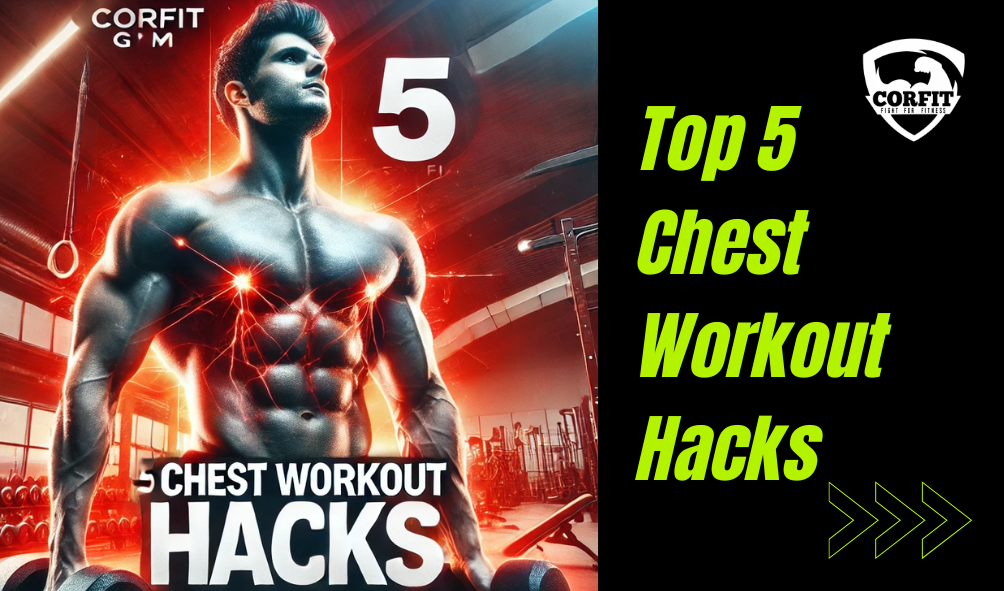A well-developed chest is essential for achieving strength, better posture, and functional fitness. If you want to maximize your gains while staying pain-free, these chest workout hacks will help you build muscle and relieve discomfort. Let’s dive into effective techniques designed to help gym-goers of all levels.
Table of Contents
1. Start with a Proper Warm-Up
Skipping a warm-up can lead to injuries and limit your performance. Preparing your body ensures better muscle activation and reduces the risk of strain.
Warm-Up Ideas:
- Dynamic stretches: Arm swings, shoulder rolls, and cat-cow stretches.
- Light push-ups: Perform 10–15 reps to activate chest muscles.
- Resistance band pulls: Use light bands for shoulder and chest activation.
Warming up improves flexibility and prepares your chest muscles for intense exercises.
2. Master the Push-Up
Push-ups are a foundational exercise for chest strength, but improper form can reduce their effectiveness.
Perfect Push-Up Technique:
- Maintain a straight line from your head to your heels.
- Lower your chest until it’s just above the floor.
- Keep your elbows slightly tucked (not flared) to reduce joint stress.
- Press up in a controlled manner without rushing.
Progressions for All Levels:
- Beginners: Incline push-ups using a bench or wall.
- Advanced: Weighted push-ups or plyometric push-ups for explosive strength.
Pro Tip: Proper push-up form targets your chest, shoulders, and triceps efficiently.
3. Use Dumbbells for Maximum Range of Motion
Dumbbell exercises provide a natural range of motion, which is ideal for activating chest muscles and minimizing joint discomfort.
Top Dumbbell Chest Exercises:
- Flat Dumbbell Press: Great for building overall chest strength.
- Incline Dumbbell Press: Focuses on the upper chest for balanced muscle development.
- Dumbbell Flys: Stretches and strengthens the chest muscles for improved flexibility.
Perform 3 sets of 10–12 reps for each exercise, maintaining slow and controlled movements.
4. Don’t Skip Post-Workout Stretches
Stretching after your workout is key to muscle recovery and preventing soreness. It also enhances flexibility, making future sessions more productive.
Effective Stretches for Chest:
- Doorway Stretch: Step into a doorway and push your chest forward to stretch the pectorals.
- Child’s Pose with Reach: Sit back on your heels, extend your arms, and feel the chest stretch.
- Overhead Clasp Stretch: Clasp your hands behind your back and lift them upwards while pushing your chest forward.
Hold each stretch for 20–30 seconds for the best results.
5. Progressive Overload: Your Key to Growth
If you want to see continuous progress, you must challenge your muscles. Progressive overload ensures your body adapts to increasing demands over time.
How to Apply Progressive Overload:
- Gradually increase the weight in exercises like bench presses or dumbbell flys.
- Add more repetitions or sets to your routine.
- Slow down the eccentric phase (lowering the weight) for added muscle tension.
Pro Tip: Track your workouts to monitor progress and ensure gradual improvements without overtraining.
6. Combine Strength and Recovery for Optimal Results
Strength gains happen when you balance hard work with proper recovery. Overtraining can lead to setbacks, so listen to your body and prioritize rest.
Recovery Hacks:
- Take 1–2 rest days between intense chest workouts.
- Use foam rollers or massage tools to relax tight muscles.
- Eat protein-rich foods post-workout to support muscle repair.

Why Focus on Chest Strength?
Strong chest muscles improve your ability to perform daily tasks, support functional movements like pushing and lifting, and boost your athletic performance. Beyond aesthetics, a pain-free chest workout ensures longevity in your fitness journey.
Ready to Achieve Your Fitness Goals?
Transform your workouts and see real results with expert guidance from Corfit Gym. Our experienced trainers, state-of-the-art equipment, and personalized plans make it easier for you to build strength and stay injury-free.

